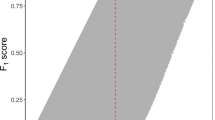Abstract
A highly accurate algorithm, based on support vector machines formulated as linear programs (Refs. 1–2), is proposed here as a completely unconstrained minimization problem (Ref. 3). Combined with a chunking procedure (Ref. 4), this approach, which requires nothing more complex than a linear equation solver, leads to a simple and accurate method for classifying million-point datasets. Because a 1-norm support vector machine underlies the proposed approach, the method suppresses input space features as well. A state-of-the-art linear programming package (CPLEX, Ref. 5) fails to solve problems handled by the proposed algorithm.
Similar content being viewed by others
References
Mangasarian, O. L., Generalized Support Vector Machines, Advances in Large Margin Classifiers, Edited by A. Smola, P. Bartlett, B. Schölkopf, and D. Schuurmans, MIT Press, Cambridge, Massachusetts, pp. 135–146, 2000; see website ftp://ftp.cs.wisc.edu/math-prog/tech-reports/98-14.ps.
Bradley, P. S., and Mangasarian, O. L., Feature Selection via Concave Minimization and Support Vector Machines, Machine Learning. Proceedings of the 15th International Conference (ICML '98), Edited by J. Shavlik, Morgan Kaufmann, San Francisco, California, pp. 82–90, 1998; see website ftp://ftp.cs.wisc.edu/math-prog/tech-reports/98-03.ps.
Mangasarian, O. L., Exact 1-Norm Support Vector Machines via Unconstrained Convex Differentiable Minimization, Report 05-03, Data Mining Institute, Computer Sciences Department, University of Wisconsin, Madison, Wisconsin, 2005; see website ftp://ftp.cs.wisc.edu/pub/dmi/tech-reports/05-03.ps. Journal of Machine Learning Research, Vol 7, pp. 1517–1530, 2006.
Bradley, P. S., and Mangasarian, O. L., Massive Data Discrimination via Linear Support Vector Machines, Optimization Methods and Software, Vol. 13, pp. 1–10, 2000; see website ftp://ftp.cs.wisc.edu/pub/math-prog/tech-reports/98-03.ps.
ILOG, Incline Village, Nevada, ILOG CPLEX 9.0 User's Manual, 2003; see website http://www.ilog.com/products/cplex/.
Cristianini, N., and Shawe-Taylor, J., An Introduction to Support Vector Machines, Cambridge University Press, Cambridge, Massachusetts, 2000.
Vapnik, V. N., The Nature of Statistical Learning Theory, 2nd Edition, Springer, New York, NY, 2000.
Schölkopf, B., and Smola, A., Learning with Kernels, MIT Press, Cambridge, Massachusetts, 2002.
Fung, G., and Mangasarian, O. L., A Feature Selection Newton Method for Support Vector Machine Classification, Computational Optimization and Applications, Vol. 28, pp. 185–202, 2004; see website ftp://ftp.cs.wisc.edu/pub/dmi/tech-reports/02-03.ps.
Hiriart-Urruty, J. B., Strodiot, J. J., and Nguyen, V. H., Generalized Hessian Matrix and Second-Order Optimality Conditions for Problems with C L1 Data, Applied Mathematics and Optimization, Vol. 11, pp. 43–56, 1984.
Facchinei, F., Minimization of SC1 Functions and the Maratos Effect, Operations Research Letters, Vol. 17, pp. 131–137, 1995.
Mangasarian, O. L., A Finite Newton Method for Classification Problems, Report 01–11, Data Mining Institute, Computer Sciences Department, University of Wisconsin, Madison, Wisconsin, 2001; see website ftp://ftp.cs.wisc.edu/pub/dmi/tech-reports/01-11.ps. See paper in Optimization Methods and Software, Vol. 17, pp. 913–929, 2002.
Mangasarian, O. L., Arbitrary-Norm Separating Plane, Operations Research Letters, Vol. 24, pp. 15–23, 1999; see website ftp://ftp.cs.wisc.edu/math-prog/tech-reports/97-07r.ps.
Matlab, User's Guide, The MathWorks, Natick, Massachusetts, 1994–2001; see website http://www.mathworks.com.
Gilmore, P. C., and Gomory, R. E., A Linear Programming Approach to the Cutting Stock Problem, Operations Research, Vol. 9, pp. 849–859, 1961.
Dantzig, G. B., and Wolfe, P., Decomposition Principle for Linear Programs, Operations Research, Vol. 8, pp. 101–111, 1960.
Chvátal, V., Linear Programming, W. H. Freeman and Company, New York, NY, 1983.
Murty, K, G., Linear Programming, John Wiley and Sons, New York, NY, 1983.
Luenberger, D. G., Linear and Nonlinear Programming, 2nd Edition, Addison-Wesley, Reading, Massachusetts, 1984.
Melli, G., Synthetic Classification Data Sets (SCDS), Report, School of Computing Science, Simon Fraser University, Burnaby, British Columbia, Canada, 1997; see websites http://fas.sfu.ca/cs/people/GradStudents/melli/SCDS/ and ftp://ftp.cs.wisc.edu/pub/dmi/data/SCDS/.
Musicant, D. R., NDC: Normally Distributed Clustered Datasets, 1998; see website http://www.cs.wisc.edu/dmi/svm/ndc/.
Murtagh, B. A., and Saunders, M. A., MINOS 5.0 User's Guide, Technical Report SOL 83.20, Stanford University, 1983; see version MINOS 5.4 Release Notes, 1992.
Author information
Authors and Affiliations
Additional information
This research was supported by National Science Foundation Grants CCR-0138308 and IIS-0511905.
Rights and permissions
About this article
Cite this article
Mangasarian, O.L., Thompson, M.E. Massive Data Classification via Unconstrained Support Vector Machines. J Optim Theory Appl 131, 315–325 (2006). https://doi.org/10.1007/s10957-006-9157-x
Published:
Issue Date:
DOI: https://doi.org/10.1007/s10957-006-9157-x




